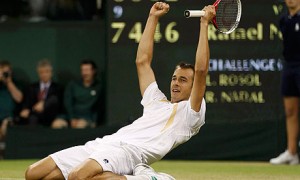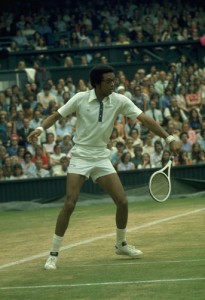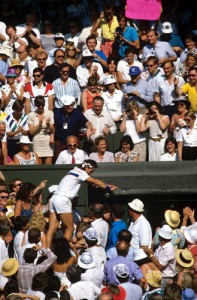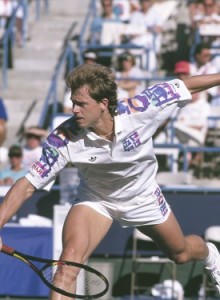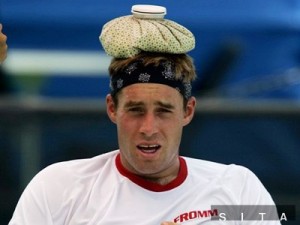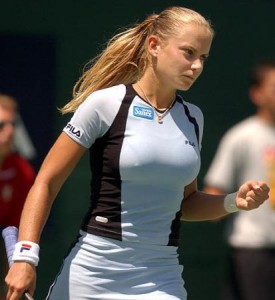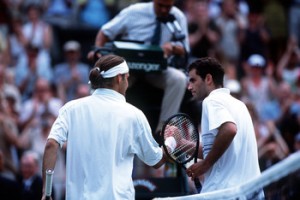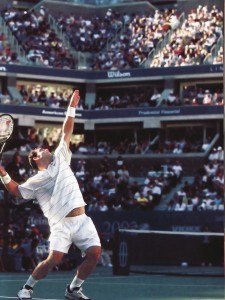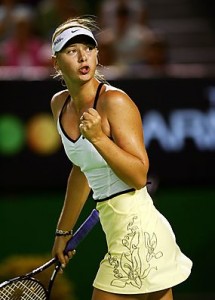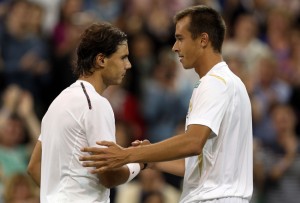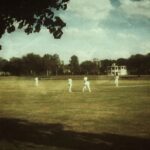The Most Dramatic Wimbledon Upsets of the Modern Era
As a society, we love upsets—when the decided underdog comes up big to knock off the reportedly sure winner. It levels the playing field for that brief moment and we all feel empowered.
So, when Lukas Rosol sent Rafael Nadal home during their second round match at the All-England Club on Thursday, it marked a true upset. One of the most startling exits at Wimbledon in recent years.
As Rosol remarked in his post-match interview, Nadal is only human.
As such, even the great Nadal has some moments when he does not play his best for whatever reason pundits can determine.
For his part, Nadal had not looked comfortable at all during his early round matches at Wimbledon in 2012; but no one suspected that the world No. 2 could be defeated at this point of the Wimbledon fortnight.
As we look back surveying previous Wimbledon tournaments, determining upsets is a matter of degrees. Whenever the unexpected happens, we call that an upset.
We will use that criteria for discussing some of the greatest Wimbledon upsets in the history of the Modern Era in tennis.
The matches discussed here are listed in chronological order.
The debate about which upset is the most shocking will be saved for a later day.
Certainly this upset of Nadal on Centre Court in 2012 ranks right up there as one of the most shocking.
1975 Men’s Final: Arthur Ashe Defeats Jimmy Connors 6-1, 6-1, 5-7, 6-4
Even though Arthur Ashe had worked his way into the men’s Wimbledon final in 1975, no one gave him much of a chance against James Scott Connors who had won the event in 1974.
Moreover, there was tension—maybe even “bad blood” between the two men on and off court.
Jimmy Connors played and won by deflecting his opponent’s power back at him, always taking the ball on the rise.
Ashe rarely defeated the wily Connors on court until the Wimbledon 1975 final.
All during that famous upset, Ashe gave Connors nothing—no pace, no power which consequently took away the Connors traditional path to the winner’s circle.
By hitting soft shots and lobs, there was no power to counter and Jimbo was hamstrung on the court.
Plus Ashe hit the ball low, making Connors hit the ball up which he did not handle well.
The strategy worked and the 32-year old Ashe defeated the 22-year old Connors in a Wimbledon Classic final.
It was an upset no one predicted and few appreciated until after the last ball was struck.
1985 Quarterfinals: Kevin Curren Defeats John McEnroe 6-2, 6-2, 6-4
It was John McEnroe who defeated the great Bjorn Borg during the Wimbledon final of 1981.
The fiery American who had appeared in the last five finals on the grand Centre Court at the All-England Club, however, was completely undone by Kevin Curren in the Wimbledon quarterfinals of 1985.
In 1984, if you recall, McEnroe had created his greatest year of professional tennis.
That was just one scant year prior to this match.
Now, in 1985, McEnroe felt the world as he knew it had come undone. The South African blew him off the court.
McEnroe fell meekly 6-2, 6-2, 6-4, winning only eight games on a court McEnroe felt he owned.
With his big, booming serve, Curren made his presence felt in 109 minutes.
It marked the end of an era for the great McEnroe whose comments at the end of the match suggested the New Yorker felt powerless out there on court.
It was a huge upset for Curren who would go on to the final only to lose to another big booming server, Boris Becker.
1987 Finals: Pat Cash Defeats Ivan Lendl 7-6, 6-2, 7-5
There was never a man more tormented by the green lawns of Wimbledon than Ivan Lendl.
Lendl held the No. 1 ranking for 270 weeks and won grand slam titles on every other surface except on Centre Court at Wimbledon.
It wasn’t that Lendl was bad on the grass. Let us say rather that he was unlucky, playing at a time when some of the greatest grass court players ever were in the game.
These would be men like John McEnroe, Boris Becker and Stefan Edberg. Lendl, in fact, advanced to the semifinals five times, losing to these men.
In 1986 it was Becker who denied him the championship when Lendl made his first All England Club final.
In 1987, however, Lendl’s best opportunity to win came as the Czech made it to the final again—this time to face Australian Pat Cash who had never won a grand slam title.
This was Lendl’s year, according to the media, whose scant belief raised expectations for the world No. 1.
After all, Becker had gone out in the second round and Lendl himself defeated Edberg in the semifinals. McEnroe was not in the field.
It was Lendl’s most opportune moment to win a Wimbledon title. But Cash did not cooperate and defeated Lendl 7-6, 6-2, 7-5.
Lendl never made another Wimbledon final.
1990 Semifinals: Zina Garrison Defeats Steffi Graf 6-3, 3-6, 6-4
It was one of those stories you wished could end the way that it should have ended. It needed that fairy-tale touch to truly warm the cockles of your heart.
But in sports, as in life, things do not always turn out the way we hope.
Even so, in 1990, American Zina Garrison did something most women playing tennis at that point in time could not accomplish.
The American defeated the great Monica Seles 3-6, 6-3, 9-7 in the quarterfinals of Wimbledon.
Then Garrison followed that feat by upsetting the fabulous German Steffi Graf 6-3, 3-6, 6-4 to advance to the finals at the All England Club.
She was given zero chance to do either.
Garrison’s high-gamble serve-and-volley style of play stilled the grunting Seles and waylaid the gazelle-like Graf.
Garrison was not only brazen in her in-your-face approaches to the net, she was deadly accurate.
All that was left was for Garrison to defeat 33-year-old Martina Navratilova, whose style of play was on a par with Garrison’s.
Navratilova was trying to win her ninth Wimbledon title, allowing her to hold the most singles titles at the All England Club.
Garrison became the first African American woman since Althea Gibson in 1958 to advance to a Grand Slam final.
But in the end, she could not overcome Navratilova to claim the title. Garrison lost 6-4, 6-1 to end a brilliant run at Wimbledon in 1990.
But her upsets of both Seles and Graf were two stunners.
1991 Semifinals: Michael Stich Defeats Stefan Edberg 4-6, 7-6, 7-6, 7-6
This is actually a story of two major upsets during a Wimbledon semifinal and final.
In 1991, in a gigantic upset, Michael Stich defeated Stefan Edberg, the reigning World No. 1, in the semifinals to reach the finals of Wimbledon.
There the German dispatched his more famous countryman Boris Becker 6-4, 7-6, 6-4 to win the trophy for himself.
It was the only time Stich won a slam final, although he had also reached the finals of the U.S. Open in 1994 and the French Open in 1996.
In 1991, having advanced from World No. 42 to World No. 6, with an ever-improving game, Stich found himself in the semifinals facing the No. 1 ranked player in the world, Stefan Edberg.
Even though Stich never broke the Swede’s serve, the German defeated Edberg in the semifinals in three straight tiebreaks after dropping the opening set. The match was riveting with Stich prevailing 4-6, 7-6, 7-6, 7-6.
It was a claustrophobic match with little room for error. Neither player had much maneuvering room. Stich remarkably held his nerve and concentrated on staying in each point.
With both players employing serve and volley, it became difficult at times to distinguish between the two, watching from the stands.
Once the dust settled, Edberg not only lost the match, he lost his No. 1 ranking which bounced back to Becker.
Instead of taking the opportunity to run with it, Becker floundered in his match with Stich, losing in straight sets.
The new World No. 1 could do nothing to stop his younger countryman from winning the Wimbledon trophy in the finals.
Stich never flew so high again, but at least he got to experience it once. His upsets go down as two of the greatest.
1994 First Round: Lori McNeil Defeats Steffi Graf 7-5, 7-6
Steffi Graf was the defending champion at the All England Club in 1994.
The German superstar was supposed to win the grass court tournament as she usually did—having won the Championship five times.
But her first round opponent Lori McNeil was not going to lay down, not even on the wet, slippery grass courts after rain became the order of the day.
Instead the American playing serve and volley tennis stayed with her German opponent stroke for stroke.
McNeil found a way to edge out Graf at the finish line in both sets, breaking her serve at the end of set one and again at the end of the tie-break.
Graf was frank after the match saying simply that McNeil was the better player that day, which was the truth.
Every champion has days when they are not playing their best tennis. This was one of the rare such days for Steffi Graf.
It remains one the biggest upsets in Wimbledon history.
1996 First Round: Doug Flach Defeats Andre Agassi 2-6, 7-6, 6-4, 7-6
The year was 1996.
The setting was Wimbledon.
Qualifier Doug Flach from the United States, ranked at 281, had just drawn his opening round opponent in the main draw—Andre Agassi.
It was Flach’s worst nightmare coming true because he had hoped to ease his way into the tournament and win another match or two.
The two were assigned to Court No. 2—where the tournament officials sent seeds to die.
It proved to be an omen. Flach served 22 aces and returned without equal, upsetting the No. 3 seed 2-6, 7-6, 6-4, 7-6.
Flach did live on to play another round.
But Andre Agassi was sent home after the first round in a major upset.
1996 Quarterfinals: Richard Krajicek Defeats Pete Sampras 7-5, 7-6, 6-4
The thing about having a long career in tennis is that normally, at the end of it, upsets become much more common.
This was the case with American Pete Sampras, who many consider one of the best to ever wield a tennis racket.
Usually, power broker Richard Krajicek crumbled in the face of victory. But at Wimbledon in 1996, Krajicek was relentless in his quest for victory.
On a second-week Wednesday, the Dutchman had Pete Sampras out on the proverbial limb as Krajicek held a 7-5, 7-6, 1-1 advantage when play was suspended because of rain.
When play resumed the following day, Krajicek finished off his dangling opponent, completing the upset by defeating the former Wimbledon champion 6-4 in the third and final set.
Krajicek would go on to win Wimbledon in an improbable year of upsets.
Chief among them was the Dutchman’s disposal of Pete Sampras in this quarterfinal match.
1999 1st Round: Jelena Dokic Defeats Martina Hingis 6-2, 6-0.
Marina Hingis was the world ranked No. 1 player in 1999.
Jelena Dokic was a 16-year old qualifier who held a ranking of 129.
These are the two major ingredients needed for a stunning upset.
The Aussie Dokic had to play three matches to qualify to get into the main draw and that gave her some experience on the grass courts
No one, however, dreamed the teenager could out-duel the No. 1 player in the world.
Hingis came into Wimbledon in 1999 after suffering an embarrassing melt-down at the French Open in a final with Steffi Graf, which Hingis lost after a temper outburst.
The Swiss Miss needed to reestablish herself during the Wimbledon fortnight. She failed.
Dokic won the last eleven games of the match, allowing Hingis only two games in the first set.
The whole match took less than an hour with the No. 1 seed dismissed in the opening round.
That was a huge upset—one of the largest in the tournament’s history.
2000 Wimbledon Final: Venus Williams Defeats Lindsay Davenport 6-3, 7-6
In order to make her way into the finals of Wimbledon 2000, Venus Williams, age 20, first had to defeat her younger sister Serena in the semifinals. That was not easy to do for the elder sister.
In 1999, to the astonishment of the tennis world, Serena Williams had defeated her older sister to win the U.S. Open in 1999––making the younger Williams sister, Serena, the first to win a Grand Slam title.
After Venus won her Wimbledon title, it marked the first time that two sisters had each won a Grand Slam championship in tennis history.
There was little doubt in anyone’s mind at the beginning of the 21st century that the Williams sisters would become forces to be reckoned with in women’s tennis for a long time to come.
Venus dispatched her younger sister in straight sets in the semifinals, creating the blueprint for a dominating Venus Williams game on grass.
Venus would go on to win five Wimbledon championships, including her triumph in 2000. In the finals, the elder Williams sister won the title, defeating defending champion, Lindsay Davenport 6-3, 7-6.
Venus became the first black woman to win the women’s trophy at the All England Club since Althea Gibson accomplished it in 1958 and 1959.
The promise of a future champ of women’s tennis emerging from the public courts of Compton, California came to fruition in that moment on Centre Court when Venus lifted the winner’s plate for all the world to see, smiling, rejoicing in her hard-fought victory.
Although many expected Venus to win, her upset of Davenport was a necessary first step to a brilliant career on grass.
2001 Fourth Round: Roger Federer Defeats Pete Sampras 7-6, 5-7, 6-4, 6-7, 7-5
If you were lucky, you were there at the inception, when the first moments of brilliance blossomed. The teenage phenom from Switzerland sporting a bandanna, his long hair swept back in a ponytail, bit at his lower lip, serving, dancing along the baseline on Centre Court.
The young challenger waited, seeing the ball as if in slow motion––coiled, poised on the balls of his feet, ready to move forward if the grizzled champion on the other side of the net returned the ball short.
From time to time the champion’s serve cracked, blasting through the court, ricocheting off service lines, often beyond the teenager’s ability to lay a racket on it.
Roger Federer’s serve surprised Pete Sampras. Not its speed, but its placement and Federer’s ability to disguise its path, using the same service motion regardless of where the Swiss decided to send the ball. His angles, his depth and his movement all worried the defending champion.
Sampras, whose seemingly languid movements around the court belied his quickness, would turn 30 shortly. The seven-time Wimbledon champion met Federer, 19, on Centre Court at Wimbledon––marking the debut of the man from Switzerland on these esteemed grounds during the fourth round in 2001.
Coming into Wimbledon, Sampras had won 31 consecutive matches on the green lawns at the All England Club and he had lost only one match in his last 57.
Sampras symbolized Wimbledon––it was his home court, the place where he felt his most invincible and could deliver the best his game had to offer.
The knock on Federer coming into this match was his inability to do well in the big moments––at the four Slams.
Coming out of the juniors, Federer was touted to be the next best and greatest. So far, the Swiss failed to live up to his billing and that troubled him, making him try too hard and go for too much.
With Sampras serving at 5-6, for a chance to even the fifth set at 6-6, the American fell behind 15-40. Federer, continuing to see the ball well, rifled back a Sampras serve for a winner, taking the set and the match 7-6 (9-7), 5-7, 6-4, 6-7 (2-7), 7-5.
As Federer fell to his knees, allowing his emotions finally to surface, Sampras sagged at the full impact of his defeat at the place where he’d enjoyed his greatest victories.
The American would never win another championship at Wimbledon.
The upset was huge in 2001.
2001 Final: Goran Ivanisevic Defeats Pat Rafter 6-3, 3-6, 6-3, 2-6, 9-7
Rain had washed out most of the scheduled matches on Saturday at the All England Club.
The men’s final was moved to Monday for the first time since 1922. “People’s Monday” brought in hordes of younger, noisier folks. For a day, Wimbledon really rocked.
It was the perfect setting as the big-serving Croat finally won the Wimbledon title in 2001 after four tries.
His enormous victory came against Australian Patrick Rafter in a thrilling five-set final 6-3, 3-6, 6-3, 2-6, 9-7.
Ivanisevic had a big serve-and-volley game with the emphasis on serve. The Croat had also reached the Wimbledon finals in 1992 where he lost to underdog Andre Agassi, whose baseline play proved to be superior on the day.
In 1994, Ivanisevic reached a ranking of world No. 2, but he could not overcome defending champion Pete Sampras in the Wimbledon final that year. Instead the Croat lost to the American in straight sets.
Nothing seemed to go the Croat’s way at Wimbledon, especially facing Pete Sampras in the final––which he did again in 1998. This time, however, Ivanisevic stretched Sampras to five sets before succumbing.
That made winning the title in 2001 all the sweeter––having tried three previous times and failed.
Lifting that trophy in 2001 made it all worthwhile for Ivanisevic as he celebrated with fans who helped push him over the finish line.
No one gave Ivanisevic much chance of ever winning this coveted prize. His upset of the much more versatile Rafter was huge.
2002 Second Round, George Basti Defeated Pete Sampras 6-3, 6-2, 4-6, 3-6, 6-4
It was the end of an era.
Pete Sampras, who had won the Wimbledon Championship on seven separate occasions, was going down to defeat at the hands of a qualifier, George Basti, in the second round.
There was nothing the former champion could do to stop the Swiss from upsetting him. Basti was ranked 145 in the world.
The committee had sent Sampras and his opponent to Court No. 2 known as the “graveyard” court to the players and their fans.
Many in Sampras’ entourage considered the scheduling on that court an insult to the tournament’s greatest champion.
The upset shocked the tennis world who knew Sampras was slipping but this defeat punctuated his demise.
Sampras would never return to Centre Court. He would, in fact, retire after winning the U.S. Open later that summer.
The defeat in 2002 marked the earliest departure of Sampras from Wimbledon in his eleven appearances at the All-England Club.
2003 First Round: Ivo Karlovic Defeats Lleyton Hewitt 1-6, 7-6, 6-3, 6-4
The giant Croat towered above Lleyton Hewitt, who was the defending champion at the All-England Club.
Ranked 203, Karlovic had finally made it into the main draw after ten tries, finding himself scheduled to meet the defending champion.
To say Karlovic was nervous was a vast understatement.
But the world No. 203 stood his ground and took the match away from the scrambling Hewitt.
It was the first time the defending champion had lost his opening round match in the Open Era of men’s tennis.
Hewitt, who had never before played Karlovic, soon discovered something special about the man standing 6’10” across the net—the man could serve.
And serve he did, with missiles often coming in at excess 135 mph. Karlovic served 18 aces which allowed him 41 service winners and the lankly lad could volley too.
Hewitt was stunned.
Soon the world would come to know Karlovic who lives on to terrify other highly seeded players who find the giant Croat in their path. No one enjoys playing against a man who serves so lethally.
2004 Final: Maria Sharapova Defeats Serena Williams 6-1, 6-4.
It was a revelation on Centre Court as the Russian Maria Sharapova won her first title over the more experienced American Serena Williams.
The teenage Sharapova played the entire match without hesitation and without fear, her aggression in full force. Not only that, the Russian did not cave in to anxiety even when she fell behind in the second set.
For a short time, it appeared that Williams might make a comeback. That possibility, however, did not last long.
Sharapova had her game plan well in mind and she did not deviate from the task at hand. She was determined to win the trophy.
In doing so, Sharapova handed Serena Williams one of her worst defeats ever in a slam final.
No one expected such a match from the 17-year old. The crowds watched in fascination as Sharapova took Williams’ game apart, leaving the American defending champion talking to herself.
This win marked the first time that neither Williams sister was not the defending champion since 1999.
It was a huge upset that unfolded on Centre Court during the women’s final in 2004.
2008 Final: Rafael Nadal Defeats Roger Federer , 6-4, 6-4, 6-7, 6-7, 9-7
It is hard to think of the No. 2 player in the world defeating the No. 1 player in the world as a major upset. But, in 2008, it was exactly that.
John McEnroe called the 2008 Wimbledon final between Roger Federer and Rafael Nadal the greatest match he had ever seen.
It was the longest men’s final in Wimbledon history, lasting four hours and 48 minutes. Rain interrupted the five-set epic twice. In the end, the No. 2 seed, Nadal, won his first Wimbledon championship, 6-4, 6-4, 6-7 (5-7), 6-7 (8-10), 9-7.
Nadal took the first two sets seemingly with ease 6-4, 6-4. Federer, however, after the rain interruption, regrouped, winning the next two sets in tiebreaks. The fifth set saw both men scrambling for every point, utilizing every ounce of ability and skill.
It was a pressure-packed last set. The quality of play, however, increased exponentially as each point brought another level of intensity. Soon it seemed like the two players were in a different world––shadows in the fading light, as each point became a matter of life and death.
When a sport is lucky enough to possess two superior champions competing in the same era, the times they meet and battle each other for that top spot can produce some memorable moments.
In 2008 this was abundantly clear, as Nadal defeated Federer in a match that neither player deserved to lose. They not only battled each other, they battled their own inner demons as well as the elements.
The loss prevented the top-ranked Federer from winning his record sixth consecutive Wimbledon title.
The rivalry between the two men continues today as well as the sportsmanship the two share. It was a momentous occasion for both men—the Wimbledon final in 2008.
How much it meant to Nadal that day was exemplified by his reaction as he climbed all the way to his box, hugging and celebrating with his family and friends.
The match was a surreal experience for those who witnessed it and surely for those who played it.
It was the first Wimbledon title that Nadal won as well as the first Wimbledon final Federer lost.
2011 Quarterfinals: Jo-Wilfried Tsonga Defeats Roger Federer 3-6, 6-7, 6-4, 6-4,
It seemed that Roger Federer was cruising through his quarter-final match with the talented Frenchman Jo-Wilfried Tsonga in 2011.
A win would send the Swiss into the semifinals where Novak Djokovic would be waiting. Federer was itching to get back to another final on Centre Court.
Federer took the first set with a break of serve, 6-3. The second set proved that breaking Tsonga’s serve was growing more difficult.
In fact, after the first set, Tsonga never relented and held his serve through the next four sets. Federer won the second set in a tie-break.
Unfortunately, after the second set, Federer could not hold onto his own serve, allowing Tsonga to break him in each of the remaining three sets.
Tsonga would go on to the semifinals where the Frenchman lost to Djokovic in four sets.
Federer, after a brilliant French Open outing, had great hopes for winning the Wimbledon title for the seventh time.
Instead he was upset in the quarterfinals.
2012 Second Round: Lucas Rosol Defeats Rafael Nadal 6-7(9), 6-4, 6-4, 2-6, 6-3
This match played at the conclusion of Day 4 in 2012 at the All-England Club sent shock waves not only throughout the tennis world, but throughout the world of sports.
It was a true upset—when an unknown and unheralded player struck down a renowned champion. That is exactly what Lukas Rosol did on Centre Court at Wimbledon on Thursday.
Ranked world No. 100, Rosol played the match of his life, defeating former Wimbledon champion, Rafael Nadal in a five set final.
The match was the last scheduled on Centre Court on Thursday and began in the light of day, ending under a closed roof with the lights illuminating the strange conclusion to a match even those watching had a hard time believing.
Could it be that the great Nadal was going to lose to this qualifier, the man from the Czech Republic?
There was a not a moment when those assembled did not believe Nadal would come back to win.
But he did not…Nadal went down to defeat.
With equal breaks of serve in the first set, Nadal managed to hang on and win the tie break, giving the world No. 2 the first set. But Rosol dominated in the next two sets, breaking Nadal’s serve while hanging onto his own serves with blistering first strike aces.
Nadal roared back in the fourth to level the match, paving the way for a fifth and final set.
But, there was a break as the tournament officials closed the roof because of the descending darkness. The process took almost 45 minutes.
Most expected Nadal to simply close out the upstart sending Rosol home after an exciting second round encounter with the world famous Majorcan.
But Rosol broke Nadal immediately and then held on to win the final set in 24 minutes.
Nadal was going home in one of the tournaments biggest upsets ever…
